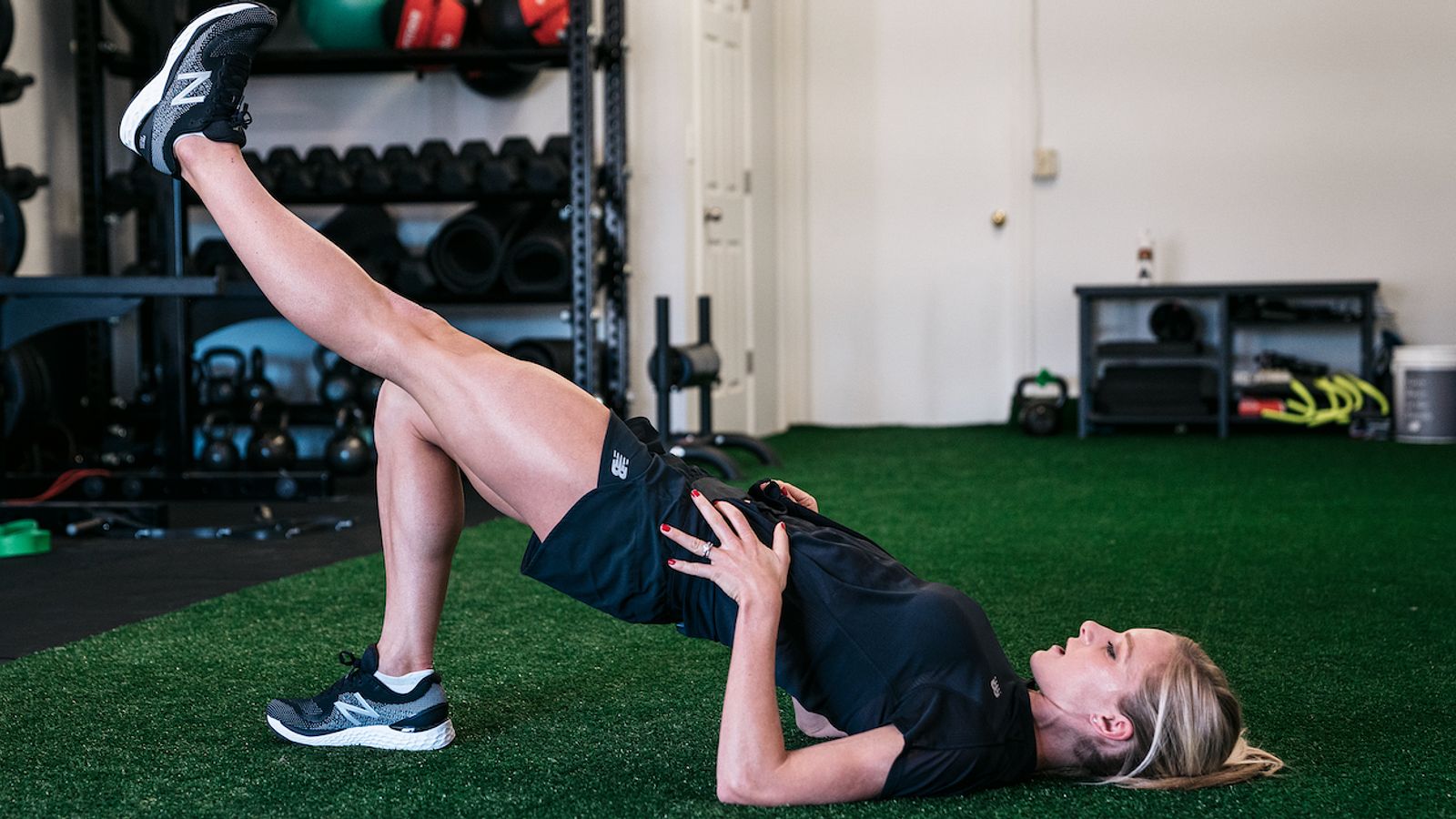Home>Misc>Featured>How Does Strength Training Help Half Marathon Training


Featured
How Does Strength Training Help Half Marathon Training
Modified: August 21, 2023
Discover how incorporating strength training into your half marathon training can improve your performance. Learn the key benefits of featured strength training exercises for runners.
Introduction
Preparing for a half marathon requires more than just logging miles on the pavement. While running is undoubtedly a crucial aspect of your training, incorporating strength training into your routine can greatly enhance your performance and reduce the risk of injury. By targeting specific muscle groups, engaging in various exercises, and maintaining proper form, you can reap the numerous benefits of strength training.
Strength training plays a vital role in improving muscular strength, power, and endurance, which are all essential for half marathon runners. It helps to build a strong foundation, enabling your body to withstand the demands of long-distance running. Additionally, strength training can enhance speed, agility, and overall running economy, allowing you to maintain a steady pace and push through fatigue during the race.
By engaging in strength training, you can also correct muscle imbalances, enhance joint stability, and prevent overuse injuries that are common among runners. It helps to correct weaknesses in specific muscle groups and improves the overall functioning of your musculoskeletal system. Furthermore, strength training contributes to increased bone density, reducing the risk of stress fractures and other bone-related injuries.
Incorporating a well-rounded strength training program alongside your running workouts can also have a significant impact on your overall body composition. It can help you to build lean muscle mass and reduce body fat percentage, resulting in a more defined physique.
Now that we understand the importance of strength training for half marathon training, let’s delve into the specific muscle groups to target, the types of exercises to incorporate, and the frequency and duration of your strength training sessions. By developing a comprehensive strength training routine, you will set yourself up for success and maximize your performance on race day.
Benefits of Strength Training for Half Marathon Training
Strength training offers a plethora of advantages for those preparing for a half marathon. While running alone can improve cardiovascular fitness and endurance, incorporating strength training into your regimen can take your performance to the next level. Let’s explore some of the key benefits:
- Improved Running Efficiency: Strength training helps to develop stronger muscles, resulting in improved running economy. This means that you will be able to maintain a steady pace for a longer period of time without expending as much effort. By strengthening the muscles used in running, such as the quadriceps, hamstrings, calves, and glutes, you can enhance your overall running efficiency.
- Injury Prevention: Running puts a significant amount of stress on the body, particularly the lower extremities. Incorporating strength training exercises can help to strengthen the muscles, tendons, and ligaments, reducing the risk of overuse injuries such as shin splints, IT band syndrome, and plantar fasciitis. It also improves overall joint stability and helps correct any muscle imbalances that may lead to injury.
- Muscle Imbalance Correction: Many runners have muscle imbalances due to the repetitive nature of the sport. Certain muscles may become overdeveloped while others remain weak, leading to poor running form and potential injury. Strength training targets specific muscle groups, helping to correct imbalances and promote better overall alignment and biomechanics.
- Increase in Power: Half marathons require a combination of endurance and speed. Incorporating strength training exercises like plyometrics, explosive movement exercises, and hill sprints can help to improve power and speed. This can give you the edge in a race, enabling you to maintain a faster pace and finish strong.
- Better Body Composition: Strength training can help to increase lean muscle mass and reduce body fat percentage. By doing so, you will not only improve your overall body composition, but also enhance your metabolic rate. This means that you will burn more calories, both during your workouts and at rest.
These are just a few of the many benefits that strength training can provide for half marathon training. By incorporating regular strength training sessions into your training plan, you can enhance your running performance, reduce the risk of injury, and improve your overall body composition.
Specific Muscle Groups to Target
When it comes to strength training for half marathon training, it’s important to target specific muscle groups that are heavily utilized during running. By focusing on these key areas, you can enhance your running performance and reduce the risk of injury. Here are some of the muscle groups to prioritize in your strength training routine:
- Quadriceps: The quadriceps are the muscles located on the front of your thigh. They play a crucial role in knee extension and provide power during push-off while running. Exercises such as squats, lunges, and leg presses can help to strengthen and develop your quadriceps.
- Hamstrings: The hamstrings are the muscles located on the back of your thigh. They are involved in hip extension and knee flexion, both of which are essential for efficient running. Incorporating exercises like deadlifts, hamstring curls, and glute bridges can target and strengthen your hamstrings.
- Glutes: The gluteal muscles, including the gluteus maximus, medius, and minimus, are vital for stability, power, and propulsion in running. Strong glutes help to maintain proper running mechanics and prevent excessive stress on other muscles. Exercises like squats, lunges, hip thrusts, and hip abductions can engage and strengthen your glutes.
- Calves: The calf muscles, including the gastrocnemius and soleus, are responsible for the powerful push-off during running. Strengthening these muscles can improve your stride and enhance your ability to maintain a consistent pace. Calf raises, skipping exercises, and stair climbing can help to target and strengthen your calves.
- Core: The core, which includes the abdominal muscles, obliques, and lower back muscles, is essential for stability and maintaining proper posture while running. A strong core can also improve your overall running economy. Incorporate exercises such as planks, Russian twists, and back extensions to strengthen your core muscles.
- Hips and Hip Flexors: The hip muscles, including the hip flexors and abductors, play a significant role in running efficiency and maintaining proper hip alignment. Exercises like hip flexor stretches, hip thrusts, lateral leg raises, and hip abductions can strengthen these muscles and improve your running form.
By targeting these specific muscle groups in your strength training routine, you can address any imbalances, enhance your running performance, and reduce the risk of injury. It’s vital to ensure that you incorporate a variety of exercises that engage these muscles to achieve a well-rounded and effective training program.
Types of Strength Training Exercises
When it comes to strength training for half marathon training, there are various exercises you can incorporate into your routine to target specific muscle groups and improve overall running performance. Here are some of the key types of strength training exercises to consider:
- Compound Exercises: Compound exercises involve multiple muscle groups and joints, making them efficient for building strength and improving overall functional fitness. Examples include squats, deadlifts, lunges, step-ups, and push-ups. These exercises engage several muscle groups simultaneously and mimic the movements used during running.
- Isolation Exercises: Isolation exercises target specific muscle groups, allowing you to focus on improving strength and endurance in those areas. For example, exercises like hamstring curls, leg extensions, calf raises, and glute bridges isolate and target individual muscles. Incorporating these exercises can help correct imbalances and strengthen specific areas of weakness.
- Plyometric Exercises: Plyometric exercises are explosive movements that help improve power and speed. They involve rapid stretching and contracting of the muscles, improving muscular power and coordination. Examples include box jumps, jump squats, plyo lunges, and burpees. Plyometrics can be used to develop explosive strength and enhance running economy.
- Resistance Band Exercises: Resistance bands are versatile tools that can be used to add resistance to various exercises. They are lightweight, portable, and can be used to target different muscle groups. Resistance band exercises such as lateral band walks, monster walks, and banded glute bridges can effectively strengthen the hips, glutes, and thighs.
- Balance and Stability Exercises: Balance and stability exercises help improve your body’s ability to maintain proper alignment and balance during running. They also strengthen the smaller stabilizer muscles that are often neglected. Examples include single-legged squats, lateral lunges, single-legged deadlifts, and stability ball exercises.
- Core Exercises: A strong core is essential for maintaining proper posture and stability during running. Incorporating core exercises like planks, Russian twists, mountain climbers, and bicycle crunches can help strengthen your abdominal muscles, obliques, and lower back. A strong core contributes to better running form and improves overall running economy.
It’s important to include a combination of these exercises in your strength training routine. A well-rounded program that targets various muscle groups and incorporates different types of exercises will ensure that you develop overall strength, balance, and stability. Additionally, varying your routine will keep your workouts engaging and prevent plateaus in your progress.
Frequency and Duration of Strength Training
When it comes to strength training for half marathon training, finding the right balance of frequency and duration is crucial. Here are some guidelines to help you determine how often and how long to incorporate strength training into your routine:
Frequency:
For optimal results, aim to perform strength training exercises at least two to three times per week. This frequency allows your muscles to recover and adapt to the increased demands placed on them. It’s essential to have rest days between strength training sessions to allow for proper recovery and to prevent overexertion and injury.
Duration:
The duration of your strength training sessions depends on your fitness level, the number of exercises performed, and the number of sets and repetitions completed. Generally, a strength training session can last anywhere from 30 to 60 minutes. It’s important to prioritize quality over quantity, focusing on proper form and technique rather than rushing through the exercises.
Volume:
The volume of your strength training, which refers to the total amount of work performed, can be determined by the number of exercises, sets, repetitions, and resistance used. It’s recommended to start with 2-3 sets of 8-12 repetitions for each exercise. As you progress, you can gradually increase the number of sets, repetitions, or resistance to continue challenging your muscles.
Progression:
As your strength improves, it’s important to progress and challenge your muscles further. This can be achieved by increasing the weight or resistance used, increasing the number of sets and repetitions, or incorporating more challenging exercises. Gradual progression ensures that your muscles continue to adapt and grow stronger over time.
Rest and Recovery:
Rest and recovery are paramount in a strength training program. Allow for at least 48 hours of rest between strength training sessions for specific muscle groups. This rest period ensures adequate recovery and minimizes the risk of overtraining and injury. During rest days, focus on activities such as stretching, foam rolling, and light aerobic exercises.
Remember, the key is to find a frequency and duration that works best for your individual needs and schedule. Listen to your body, and adjust accordingly to prevent burnout or overexertion. As with any training program, consistency is key. Regularly incorporating strength training into your routine will yield the best long-term results and enhance your performance in your half marathon.
Importance of Proper Form and Technique
When it comes to strength training for half marathon training, one of the most important factors to consider is proper form and technique. While it may be tempting to focus on lifting heavy weights or completing a high number of repetitions, it’s vital to prioritize quality over quantity. Here’s why proper form and technique are crucial:
- Prevention of Injury: Performing exercises with incorrect form and technique increases the risk of injury. Proper form ensures that you engage the target muscles effectively while minimizing stress on joints and other supporting structures. By maintaining proper alignment and technique, you can reduce the likelihood of strains, sprains, and other exercise-related injuries.
- Targeting the Right Muscles: Correct form ensures that you are effectively targeting the desired muscle groups during exercises. Improper form can lead to compensatory movements and the activation of incorrect muscles, which prevents you from achieving the desired training effect. By focusing on proper technique, you can maximize the benefits and results of your strength training workouts.
- Enhanced Muscle Activation: Proper form and technique facilitate optimal muscle activation during exercises. By executing movements correctly, you ensure that the intended muscle groups are properly engaged and bear the brunt of the resistance. This leads to more efficient muscle development, improved strength gains, and better overall performance during your half marathon training.
- Improved Movement Efficiency: Proper form carries over to better movement efficiency while running. By practicing good form through strength training, you train your body to maintain better biomechanics, posture, and alignment. This translates into more efficient and injury-free running mechanics, allowing you to perform at your best during your half marathon.
- Long-Term Progress and Performance: Consistently practicing proper form and technique builds a solid foundation for long-term progress and performance. It allows you to continually challenge yourself, progress in your strength training program, and achieve optimal results. It also ensures that you are performing exercises correctly as you increase resistance or intensity, reducing the risk of setbacks due to injury or poor mechanics.
Remember, it’s essential to prioritize proper form and technique over the amount of weight lifted or the number of repetitions completed. Focus on performing exercises with control, maintaining proper alignment, and engaging the intended muscle groups. If you are unsure about proper form, seek guidance from a certified strength and conditioning professional to ensure you are performing exercises correctly.
By prioritizing proper form and technique in your strength training workouts, you can minimize the risk of injury, optimize muscle activation, and improve movement efficiency. This, in turn, will support your overall half marathon training and help you achieve your performance goals with greater success.
Balancing Strength Training with Running Workouts
When incorporating strength training into your half marathon training, it’s important to find the right balance between your strength training sessions and your running workouts. Properly managing these two components of your training program will ensure optimal performance and minimize the risk of overtraining or injury. Here are some key considerations for balancing strength training with your running workouts:
- Schedule: Plan your training schedule in a way that allows for adequate rest and recovery between your strength training and running sessions. Aim to have at least 24 to 48 hours of rest between your intense running workouts and strength training sessions to give your muscles ample time to recover and adapt.
- Prioritize Key Running Workouts: Identify the key running workouts in your training plan, such as long runs, tempo runs, or speed workouts. Prioritize these sessions and schedule your strength training sessions on days that allow for maximum performance during these key runs. Avoid scheduling intense leg-focused strength training sessions the day before or after your long runs or speed workouts. This will prevent excessive muscle fatigue and allow you to perform at your best during these important running sessions.
- Consider the Timing: The timing of your strength training and running workouts can also impact your performance. Some runners prefer doing their strength training sessions on separate days from their running workouts to ensure they can devote their full energy to each component. Others prefer performing their strength training after their easy or recovery runs to maximize muscle activation and aid recovery.
- Maintain Flexibility: Be flexible with your training schedule and adjust as needed. If you’re feeling fatigued from a challenging strength training session, it may be beneficial to switch a planned running workout to a light recovery run or rest day. Listening to your body and making modifications when necessary can help prevent overtraining and reduce the risk of injury.
- Gradually Increase Intensity: As you progress in your half marathon training, gradually increase the intensity of your strength training sessions and running workouts. Gradual progression allows your body to adapt and minimizes the risk of overexertion or excessive muscle soreness. Gradually increasing the resistance, repetitions, or duration of your strength training exercises can help enhance muscle strength and endurance efficiently.
- Recovery and Rest Days: Make sure to incorporate regular rest days and recovery techniques into your training plan. Rest days allow your body to recover, repair, and adapt to the training stress. Incorporating recovery techniques like foam rolling, stretching, and proper nutrition can also aid in muscle recovery and reduce muscle soreness.
Remember, finding the right balance between strength training and running workouts is crucial for optimal performance during your half marathon training. It’s important to prioritize recovery, listen to your body, and make adjustments as needed. By properly balancing these components, you can enhance your running performance, reduce the risk of injury, and reach your half marathon goals with confidence.
Sample Strength Training Routine for Half Marathon Training
An effective strength training routine for half marathon training should focus on targeting key muscle groups, improving running performance, and reducing the risk of injury. Here’s a sample routine that you can incorporate into your training plan:
- Warm-up: Begin with a dynamic warm-up to prepare your muscles for the workout. This can include exercises like walking lunges, high knees, butt kicks, leg swings, and arm circles. Perform each exercise for 10-15 repetitions or as desired.
- Squats: Squats target your quadriceps, hamstrings, glutes, and core. Perform 3 sets of 12 repetitions, focusing on maintaining proper form and technique. You can use body weight or add dumbbells for more resistance if desired.
- Lunges: Lunges work the quadriceps, hamstrings, glutes, and calves. Perform 3 sets of 10 repetitions for each leg, focusing on proper form and depth. You can do forward lunges, reverse lunges, or walking lunges.
- Deadlifts: Deadlifts target your hamstrings, glutes, lower back, and core. Perform 3 sets of 8 repetitions, using a barbell or dumbbells. Focus on maintaining a neutral spine and engaging your core throughout the movement.
- Calf Raises: Calf raises strengthen your calf muscles. Stand with your feet hip-width apart, rise up onto your toes, and then lower back down. Perform 3 sets of 15-20 repetitions.
- Plank: Planks are great for core strength and stability. Hold a plank position for 30-60 seconds, focusing on keeping a straight line from head to heels. Repeat for 3 sets.
- Hip Bridges: Hip bridges target your glutes, hamstrings, and lower back. Lie on your back with your knees bent, lift your hips off the ground, and squeeze your glutes at the top. Perform 3 sets of 12 repetitions.
- Single-Legged Deadlifts: Single-legged deadlifts improve balance, stability, and hip strength. Stand on one leg, hinge forward at the hips while extending the opposite leg backward, and then return to the starting position. Perform 3 sets of 10 repetitions on each leg.
- Side Plank: Side planks target your obliques and lateral core muscles. Lie on your side with your forearm on the ground, lift your hips off the floor, and hold for 30-60 seconds. Repeat on both sides for 3 sets.
Remember to start with lighter weights or body weight and gradually increase the resistance as you become stronger and more comfortable with the exercises. Focus on maintaining proper form, breathing, and engaging the target muscles throughout each exercise.
This is just a sample routine, and you can modify it according to your individual needs and preferences. Consult with a certified strength and conditioning professional to personalize your strength training routine and ensure it aligns with your half marathon training goals.
Conclusion
Incorporating strength training into your half marathon training can have significant benefits for your overall performance and long-term success. By targeting specific muscle groups, improving running efficiency, preventing injuries, and enhancing your body composition, strength training becomes a valuable addition to your training regimen.
Throughout this article, we’ve explored various aspects of strength training for half marathon training. We’ve discussed the importance of targeting specific muscle groups such as the quadriceps, hamstrings, glutes, and core. Additionally, we’ve highlighted different types of exercises including compound movements, isolation exercises, and plyometrics. We’ve also emphasized the significance of proper form and technique to maximize results while reducing the risk of injury.
Furthermore, we’ve covered the importance of balancing strength training with your running workouts. By carefully scheduling and prioritizing key running workouts, allowing for proper rest and recovery, and gradually increasing intensity, you can find a harmonious balance between strength training and running.
Lastly, we provided a sample strength training routine to give you an idea of how to structure your own workouts. Remember, this is just a starting point, and it’s important to customize your routine based on your individual needs, fitness level, and goals. Seeking guidance from a certified strength and conditioning professional can be invaluable in developing a personalized strength training program.
Integrating strength training into your half marathon training will not only improve your performance in the race but also contribute to your overall fitness and well-being. Take time to listen to your body, prioritize recovery, and continually challenge yourself in your strength training journey. By doing so, you’ll be on the path to becoming a stronger and more resilient runner.









